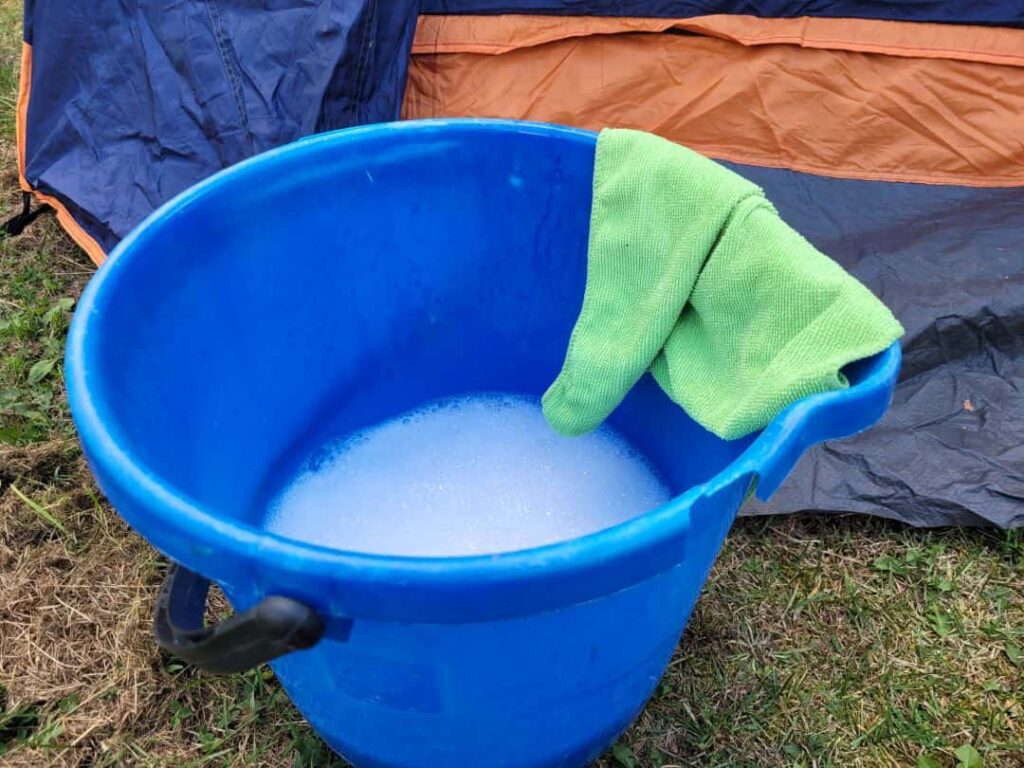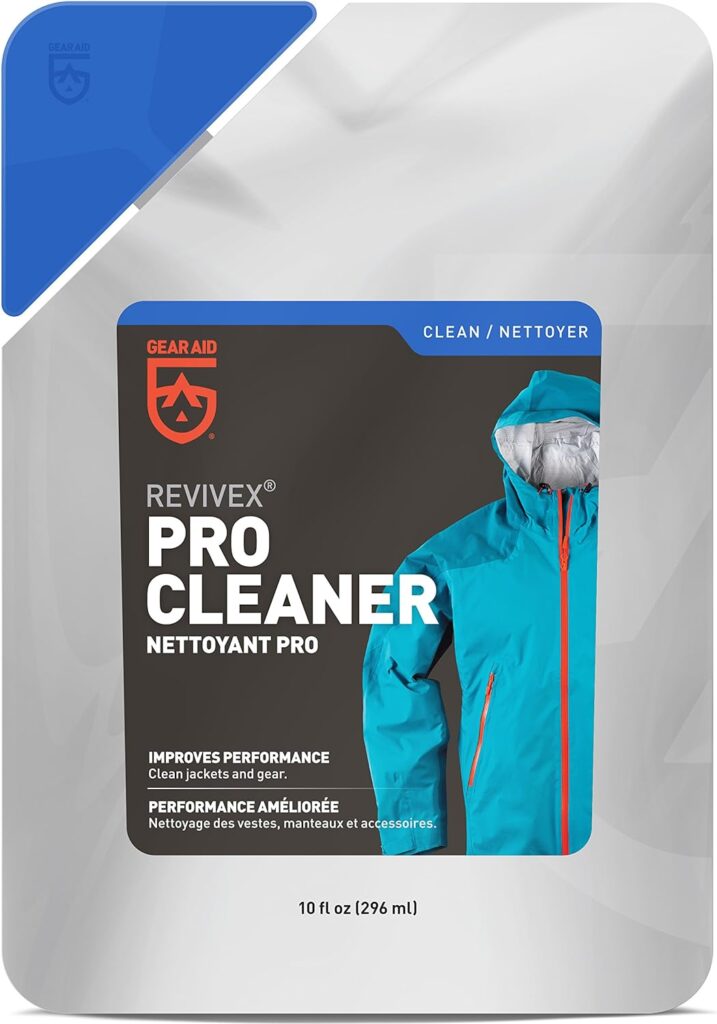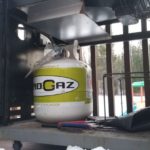Cleaning a tent with mold on it doesn’t have to be too difficult, as long as you have the right tools for the job!

When tents are packed away without first being completely dried out, they can start to grow unwanted mold and mildew. Maybe you packed the tent up after a rather wet camping trip, or early in the morning before the sun had a chance to dry the dew off.
Whatever the case may be, the easiest way to prevent mold, mildew and odors from forming on your tent is to unpack it once you get home and dry it out in the backyard. Of course, no one feels like doing that after arriving home from a trip away and sometimes we can easily forget.
When that happens, don’t despair too much. Tents can usually be pretty easily cleaned with a little elbow grease and some form of cleaning product.
Checking your Tent for Mold
So you have a big camping trip planned for the upcoming weekend and of course you just remembered that the last time you used your tent, you stored it away wet. Now there’s a fairly good chance that your tent has grown some mold and will have an unwanted odor to it as well. That’s when you know you should check it out before you head out for the weekend.
You’ll want to pull the tent out of the storage bag and check for small black, blue or green mold spores. You might also notice a musty, moldy smell once you open the bag.
If the tent is dirty, moldy and smelly, then you’ve got to clean it before taking it out for the next camping trip as mold can damage a tent by weakening the fabric. It’s also unsightly and the weakened fabric can lead to tears and holes, reducing the tent’s longevity. Getting the tent back to a clean state shouldn’t be too difficult as the fabric is generally pretty easy to clean.

The Difference between Mold and Mildew
While mold and mildew are both fungi that grow in damp environments, there are a few distinct differences between the two.
Mold often has a raised profile and can become fuzzy. It can usually be easily wiped away, although removing the entirety of it does require a little scrubbing and some cleaner.
Mildew is often flat and powdery with a lighter color such as white or brown while mold is darker colors.
Picking the Right Tools to Clean your Tent
When choosing the equipment to clean your tent with, the most important thing is to choose products that won’t damage the fabric. Things like bleach can damage the color of the tent while using rough bristle brushes can damage the waterproofing and pull the fabric stitching.
In order to reduce the risk of damage, it’s best to use gentle products such as soft sponges, microfiber clothes, vinegar, soap and natural products whenever possible.
Quick Guide to Cleaning a Tent with Mold, Mildew and Odor
- As soon as you know your tent has mold, set it up in the backyard on a sunny day to dry out. The sun rays will deactivate the mold spores, but the staining will remain and will need to be cleaned.
- Determine the severity: a few mold spots=spot clean with a spray bottle of vinegar and water or liquid soap and water. Major mold=soaking the tent or using a specialized cleaning product such as Revivex Pro Cleaner.
- Using a gentle brush, sponge or cloth and the chosen cleaning product, rub the mold spots away.
- Rinse the tent with a garden hose to remove the cleaning product.
- Let the tent dry completely.
- If necessary, reapply the tent waterproofing.
A Few Cleaning Solutions that Work
There are many tried and true cleaning solutions and products that work well. The one you choose will depend on the severity of the mold, the cost of the products and in some cases whether you prefer safe home remedies to over the counter products. These are a few of the most effective solutions:
- Dish detergent and water
- Vinegar and Water
- Rivivex Odor Eliminator
- Nikwax Tent and Gear Solarwash
- Gear Aid Rivivex Pro Cleaner
Step by Step: How to Clean a Tent with Mold
The first step to cleaning a moldy tent is determining the amount of mold that is present. If there are just a few localized spots, then spot cleaning the tent with a soapy, wet sponge will likely do the trick. Simply rub the spots clean and let the tent dry completely before storing it.
For tougher projects where a large portion of the tent has mold and a noticeable odor, a little more work will be required. You can choose to start by doing one of two things; either soak the tent completely or work in sections.
Soaking a Moldy Tent
You can soak a tent in a bathtub, washtub or a large storage container. Use a mixture of lukewarm water and liquid detergent soap to soak the fabric. Set the tent up in the backyard so it is easy to work with. Next, use a gentle brush, sponge or microfiber cloth to wipe the mold spores away.
Soapy Water to Clean Mold from a Tent
Liquid detergent and water can often do the trick for removing mold and mildew from tents and will also eliminate any bad odors. To hand wash a tent with soap and water, fill a small bucket with warm water and add a couple of teaspoons of laundry detergent or dish soap. Mix that around a little so you have a sudsy formula and wipe onto the tent with a sponge or microfiber cloth.
You may need to reapply to the tent several times, depending on the severity of the mold. You should see a noticeable difference fairly quickly, but if the mold has penetrated the fabric of the tent, it will be difficult to completely remove the discoloration.
Rinse the tent or soak it in a bathtub of cool water to remove the soap.
This same method can be used with a mixture of vinegar and water or you can use vinegar on it’s own.

Using a Spray to Clean a Moldy Tent
You can also choose to skip the soak and instead spray or wipe a cleaning mixture on the tent as you work. If doing so, again it is easiest to do so with the tent set up in the backyard or a large room with plenty of space to work.
Simply spray your homemade mixture of soap and water, vinegar and water or Rivivex or other cleaning product onto the mold spores. Let the cleaner soak into the fabric and gently brush or wipe away the mold. Be careful not to scrub too roughly as you might wear off the waterproof coating or even start to pull at the fabric causing damage to your tent.
Brushing in small, gentle circles and changing directions with your brush will help to clean into all of the little crevices within the fabric.

Drying out the Tent
No matter what method you use to clean mold and mildew off your tent, it is very important to dry it out completely before storing it. This will help to avoid any new mold from growing. Leave the tent set up outside in the sun for the day or in a nice, dry location. Always put the tent back in the storage bag and store it in a dry area of your home or garage to avoid any further issues.
Reapplying Tent Waterproofing
Once completely cleaned, it’s a good idea to check the tent for any damaged waterproofing that will lead to leaks in a rainstorm.
If you find any areas where the waterproofing seems to have been removed, specifically in the stitching seams, then you’ll want to reapply to avoid unwanted leaks.
Scotchguard Outdoor Water Shield is a great product for tent waterproofing. To apply it, just spray the whole outside of the tent and allow it to dry completely. Pay particular attention to those tent seams which are prone to wearing. It’s a good idea to give the seams a second coat of waterproofing as well.
Once completely dry, store the tent in a cool, dry area so it’s ready for your next camping trip.
If you found this helpful, you might also be interested in knowing how to clean your cast iron grills
We love writing about the things that make a real difference in your outdoor experience. Some of the links in this post are affiliate links in which case we may earn a small commission at no extra cost to you if you make a purchase. We truly appreciate you taking the time to read our content and hope it has added value to your next camping and outdoor adventure.




